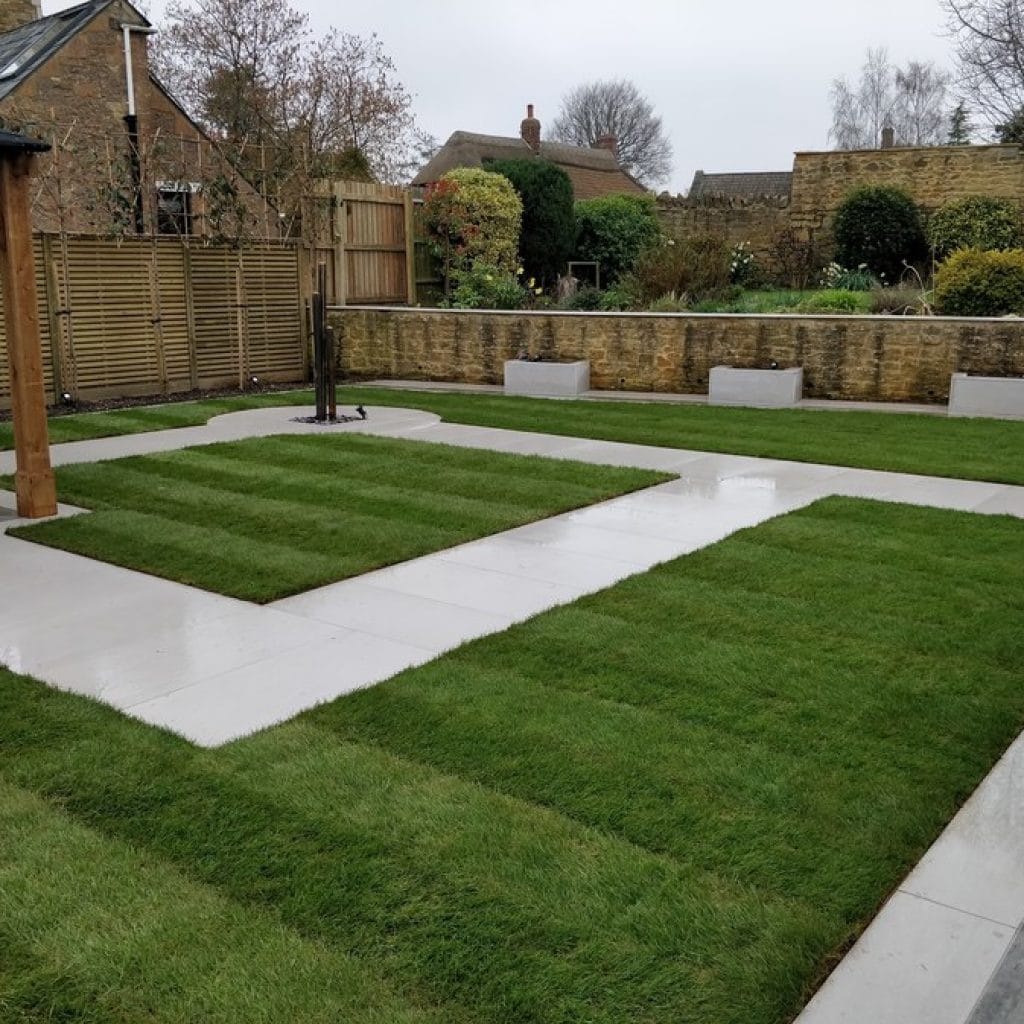Your Garden Heatwave Recovery Plan
UK gardens have suffered in the recent hot dry weather. Here’s a heatwave recovery plan to help your garden to recuperate.
If your garden is looking a bit sorry for itself after this year’s hot dry summer, you’re not the only one. The changing of the seasons always makes us reassess our outdoor spaces. As the weather cools we’re probably expecting to spend less time lying on sun loungers and more time being a wee bit more active……barbecuing and gathering with friends to enjoy the last of the mild weather and long evenings.
Here are a few tips on refreshing your garden. We’re focusing on a heatwave recovery plan and preparing to welcome autumn.

A well designed and well built garden feature like this will look good all year round with the minimum amount of maintenance
Patios And Paths
Its quite possible that hard landscaping features have got a wee bit dusty over the summer months. If you’ve been eating al-fresco, you may also have a few marks on the stone from spillages.
Sweep dust and debris off first, then use a proprietary stone cleaner to mop up those marks. Next you can refresh your patio with a solution of eco-friendly washing up liquid dissolved in water and rubbed in with a soft bristle brush before being rinsed off with clean water.
Please don’t use bleach or harsh chemicals on your patio. Not only could it damage the pavers, it’s terrible for the environment. Pressure washers are a no-no too – they erode the surface and weaken the grout between pavers.
If in any doubt about how best to clean your patio, please give me a ring or send me some pictures. I’m always happy to advise.
Decking And Fencing
Composite decking and fencing can be brightened up quite quickly with a quick wash down with soapy water. Sweep your decking first to remove any debris (it’s surprising what accumulates in the corners). Because composite products are rot proof, this is all the maintenance you’ll need to do. And if you’re happy with the appearance – well, you don’t even need to do this!
Natural timber decking and fencing. Hot dry weather can play havoc with untreated timber. Cedar and larch fencing have natural oils within to protect the wood. They probably won’t need any attention at all.
Check your decking though, if it’s looking parched, then a nice refreshing treatment with decking oil will protect it from water ingress over the winter.
Lawns
Oh dear, natural lawns really have taken a battering during the drought. For most people, including me, the lawn has been golden for several weeks. But that’s OK, grass has an inbuilt drought protection mechanism. It will green up quickly once we get some decent rain showers.
You can speed up your lawn’s heatwave recovery by spiking the lawn all over to allow rain to penetrate the ground faster. Then, once the soil is damp, apply an autumn-winter formula lawn feed and boost its effectiveness with a seaweed tonic.
There’s a very good drought recovery plan for parched lawns on the Premier Lawns Website. Click here for expert advice from Robbie Lynn.
Artificial grass can be freshened up at this time of year just by giving it a once over with a good stiff broom. You’ll revive the pile and remove any debris. If you have pets, you might want to give it a gentle wash with a deodorising disinfectant.

It doesn’t take long for a lawn to recover from a heatwave. A cheeky trick to improve its appearance is to mow stripes into the lawn – they instantly make it look better.
Trees and Hedges
As I travel around Somerset, I can see that established trees and hedges have survived the heatwave quite well. Some of the horse chestnut trees look a bit crispy around the edges, but that’s not unusual for this time of year. Environmentalists are telling us to expect trees to drop their leaves early this autumn but I guess we’ll just have to wait and see.
I’m sure If you have newly planted trees and shrubs in your garden, I’m hoping that you’ve been watering them through the summer. If not, and they’re looking a bit sad, give them a really good drenching, remove any weeds and mulch mulch mulch
Adding mycorrhizal fungi to the soil around trees and hedges should speed the heatwave recover process and help to make the plants more drought resistant next year.
Beds and Borders
It’s normal for herbaceous borders to need a good tidy up at the end of summer, but this year some of them look a bit more battered than others. Particularly if they don’t have an irrigation system in place.
Wade in there with your secateurs and deadhead all of the flowering plants. Some of the vegetation may look dead, but there’s a chance it will revive after rainfall so be selective about removing crispy bits. As a rule of thumb, if a leaf or stem will bend rather than snap, the plant is still alive.
The most important thing you can do for your beds and borders right now is to ensure that the plants’ roots have everything they need to build their strength during the winter. My advice would be to work some mycorrhizal fungi into the soil and then mulch with well rotted manure or compost – the worms will do the rest. If the soil is very dry, the plants will welcome a good watering. But please don’t breach any hosepipe bans to do so.
In late September, you can plant some spring flowering bulbs in your borders to give you a brilliant show early next year. Snowdrops will put a smile on your face in February, crocus look fabulous in March and they can be followed by narcissi and tulips.

A great planting scheme can make your garden feel cool and comfortable on the hottest of days.
Futureproofing Your Garden
I honestly believe that we can expect to see more mediterranean type summers in future. And that’s no bad thing, IF you are set up for it. Hot weather never seems to be a problem when we’re abroad and people have been living in warmer climates than ours since time began. We just need to learn lessons from other cultures and adjust our gardens to suit.
So what could you have done differently in your garden this summer?
- Would you have liked a bit more shade?
- More seating areas so that you could follow the sun around the garden?
- An irrigation system for your plants?
- Plants that were more drought resistant?
- An outdoor kitchen so that you could escape the heat of the house?
- What about some kind of structure so that you could sleep under the stars on a hot night?
- More water butts so that you can capture and store water over the winter months?
If you are planning changes to your garden to help you through the next heatwave, please don’t hesitate to get in touch. I’m bursting with ideas for dry gardens, gravel gardens, mediterranean gardens and more.
Good luck with your garden’s heatwave recovery program, there’s a bit of work involved, but now the temperature has dropped, I’m sure it will feel good to be moving around outside and soaking up the last of the summer sunshine.
Contact Dan to discuss your garden plans for next year
How sustainable is landscaping? Does it help to mitigate climate change? Dan from SilverBirch Gardens shares his opinions in this blog.
How to make your garden more interesting all year round




